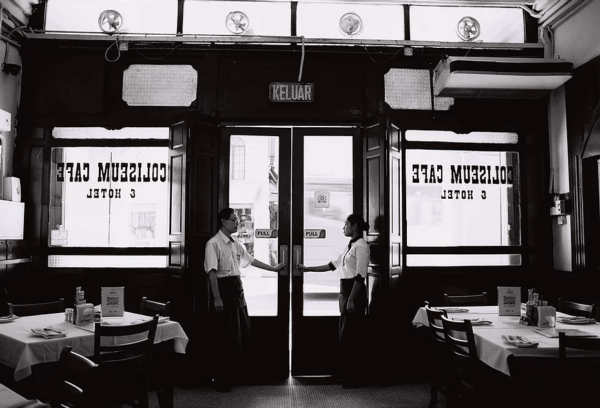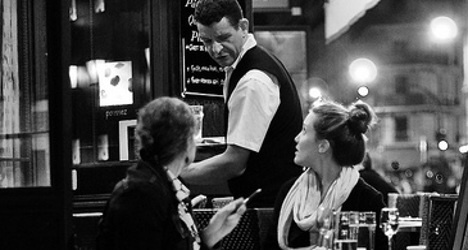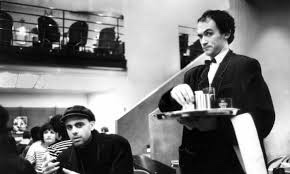Last week, the tenured restaurant critic of The Washington Post, Tom Sietsema, popped off in a cringeworthy column about how service has been especially lackluster in restaurants lately. “Two years into the pandemic, some diners’ patience has grown thin as angel-hair,” Sietsema writes. “The elephant in the room? Service, or the lack thereof.” Without explicitly saying it, the title of the article should have been: “Can we start complaining in restaurants again?”
From my vantage point, the elephant in the room is an out-of-touch food critic. I don’t doubt there’s merit to what Sietsema’s reporting. Service standards are likely slipping, which is understandable given that the industry has been stuck in a deep, muddy ditch for two years since the onslaught of Coronavirus. Has the pandemic dust settled enough that it’s safe to start airing our grievances? Sietsema apparently thinks so. He conveys a detailed anecdote of having dined out on Christmas in Santa Fe where he felt the service was so indefensibly bad that he had to leave a note for the manager.
Sietsema neglects to mention that Omicron was peaking in December, Covid-19 cases in the U.S. at the time were hovering near record territory, on average over 400,000 daily cases. But he was determined not to let the spirit of Christmas destroy his primordial need to criticize restaurants. “Am I Grinch? Or a diner looking out for others?” he queried his Twitter followers. “You’re not a Grinch, you’re a douchebag,” another account flippantly replied.
Sietsema assured his social media followers that he left his server a very generous tip. (Which of course always absolves anyone from being a total asshole in a restaurant because, money.) He also insisted that his feedback was “civil and specific,” acknowledging the difficult circumstances and it being Jesus’ birthday and all. Aside from sharing opinions about food and restaurants, the critic also appears to fashion himself a guardian of the public’s dining interests. Alerting management, he concluded, was worth it—despite his misgivings—because it might protect future guests from suffering the same fate.
Putting aside his petty grievances for a moment, Sietsema’s article turns its focus on how restaurants can fix things despite all these impediments. His framing is very telling. In order to figure out how to remedy the pandemic-related problems, he interviews the people who are the suffering the most to find out what they can do to fix it. All citizens must cope with the ill effects of the pandemic, but when you dine in a restaurant the servers are expected to pick up the slack and provide comfort for the served. That’s the way it is and always will be—no matter how bad things get—and that’s why so many of us left the industry for good. We’re tired of shouldering the burden of having to make ambivalent people happy.
Among other shortcomings, Sietsema complained that his server didn’t ask why so much food was left on his plate, as though he couldn’t just tell the server he didn’t like the dish. His mask is off, the server’s on, yet he expects the server to be the one speaking up? Once again, it’s up to the server to fix the problem, to extract information from an otherwise silent subject. Was he worried that confronting the server or a manager in the moment would somehow make things worse? I’d argue that approaching it passive-aggressively with a written statement is more insulting. Why not give the staff the opportunity to make it right? I guess then he wouldn’t have fodder for his next column.
He heralds the manager contacting him to make amends as affirming his belief that he’d acted prudently. But what else is the manager supposed to do? Trust me: Every restaurant manager on the planet, if they could, would love to tell Tom Sietsema to go fly a kite after receiving a Christmas card like this. But, in real life, they have to smooth things over. Restaurant managers have only two options when they field a complaint: ignore it or apologize. Sietsema assuming the apology is genuine is terribly naive, almost laughable.

Like many of America’s long-tenured restaurant critics (mostly white men), Sietsema may be getting a little long in the tooth. This is his twenty-second year as restaurant critic for The Washington Post. Two decades is an awfully long time to trust one person’s palate and hospitality ideals. Whether Sietsema realizes it or not, there’s a measure of white privilege embedded in his hyperbolic disappointment caused by one meal in Santa Fe. (He even uses the phrase “willing to pay for the privilege” in opening of his article.)
Sietsema’s column helped crystallize my belief that restaurant critics should have term limits. The New York Times, for one, has never had a person of color as the chief restaurant critic. I’m guessing the lineage of Washington Post food critics isn’t any more distinguished in this regard. According to an article by Laura Hayes in the Washington City Paper from 2019, the D.C. region is only 41% white and yet has no critics of color in any of its major news outlets. (Hayes is herself white but does not write reviews for WCP.)
I’m guessing that Sietsema is aware that a healthy percentage (if not the wide majority) of the people cooking, serving, and cleaning up after him when he dines out on the company dime are people of color. Most of these people are invisible to him. Like the dishwasher who has to scrape all the wasted food off his plate that he concluded wasn’t up to snuff and the porter who takes out his garbage at the end of the night. The menial wages of these workers help subsidize the price of Sietsema’s meal, even though he’ll likely still gripe about the escalating cost of dining out in his next review to show solidarity with his fellow entitled diners. It makes me wonder if a non-white critic would ever approach a delicate issue like this with such haughtiness.
Sietsema ignores the fact that kitchen workers, more so than any other profession, have died in alarming numbers since the onset of Covid-19. In many cases it’s because restaurant workers can’t afford to put their work lives on hold. We should be showing our appreciation for that sacrifice and being thankful we still have restaurants to convene in, not writing think pieces that scrutinize service lapses and patting ourselves on the back for nitpicking.
Aside from his nebulous critique, Sietsema seems to have a poor fundamental understanding of how restaurants function. He writes about being denied a banquette table because it was reserved for a larger party (he arrived as a party of two). After being seated somewhere less desirable, he bristles when a host later gives the banquette to another couple. An experienced restaurant professional (which Tom is not) would know that the host or maitre’d likely had a plan based on the reservation manifest to seat a larger party at that table. Those plans change frequently throughout the course of the night when reservations cancel last-minute or parties unexpectedly no-show without warning. Sadly, it’s quite common for guests like Sietsema to be annoyed that they can’t have the table of their choice without making any effort to understand the mechanics behind the decision. It’s “me first” no matter what.
Before Tom pontificates about declining service, he should mask up and work a shift with the maitre’d of one the busiest restaurants in town. Go witness the Tetris puzzle they deal with up close every night, and how difficult it is to seat everyone on time and at a comfortable table for their party size. See how well it works if you let everyone pick their furniture. Write an article about that. His readers, who apparently agree that the quality of service is declining lately, could certainly benefit from a deeper understanding about how difficult it is for restaurants to maintain service standards when so many guests put their needs above others, especially during a pandemic. (See: Guests who physically assaulted a hostess in a New York City restaurant for asking for proof of vaccination.)
Look, Covid fatigue is real. I get it. But two years into the pandemic, servers are still expected to put themselves at risk of getting sick and wear protective gear when guests often don’t extend the same courtesy. Most front of house staff do this five nights a week, at least eight hours a day. Their tips go down every time there’s a new variant, yet they’re expected to perform at the highest level. Staff across the country are still stretched thin which means people are forced to work double shifts that can often last over twelve hours just to keep the doors open.
Sietsema’s pandemic Christmas fiasco highlights the inherent imbalance of power that exists when care is exchanged for money. Many guests wield that power recklessly, and servers have no weapons in their arsenal to fight back. The customer may not always be right, but the customer almost always wins. Instead of recognizing the turbulent conditions and laying down his arms, Sietsema decided to drop a hand grenade on the way out.
It’s irresponsible for restaurant critics to use their platforms to reinforce tired tropes around customer entitlement. Restaurants don’t owe us anything. Excellence is a bonus, and we can vote with our dollars when it’s lacking, but hiccups in service should be eminently forgivable, especially under such duress. Often when customers are unwilling to forgive disappointing service, they’re blaming the staff for their miserable time when their misery started in the parking lot. Guests like this project the image of their own failings onto the restaurant. I’ve seen it a million times. But regardless of whether there’s merit to Sietsema’s or anyone’s grievances about bad service right now, the climate for restaurant businesses is drastically different today.
The effects of the pandemic should temper our expectations of restaurants and encourage us to think about how we can better support them beyond our purchasing power. Money isn’t enough. The restaurant industry needs better guests right now more than guests need better restaurants. We need patience, empathy, and forgiveness. There are so many ways we can support restaurants that don’t involve criticizing them.
The restaurant industry needs better guests right now more than guests need better restaurants.
The last two years have taught us that restaurants have no safety net. You wouldn’t walk into a theater that just had a massive fire and expect to see an entertaining show. The restaurant industry has just undergone an extinction-level event, and a majority of the public is behaving as though nothing’s changed—continuing to flake on reservations, confronting staff over masking or vaccination policies, and deriding higher prices even though inflation is a global problem.
I’m not saying that all critics, or guests for that matter, should have to be cheerleaders for restaurants. But all of us should have some measure of discretion when the economic headwinds are so strong not to pile on. We don’t need critics to tell us about everything we deserve when we spend money somewhere or framing their criticisms around lofty expectations. Restaurants cannot provide unconditional love to everyone right now—understandably so—and we need to stop pretending that they should.
But there’s something deeper going on here beneath the surface, an ingrained sense among diners that we’re owed excellence, if not perfection, when we dine out. By exercising his right to speak out on Christmas of all days, Sietsema seems to be testing his own level of depravity as an entitled guest. My question is: If we can’t put aside that sense of entitlement now as diners, when will we ever? My advice to you (and to Mr. Sietsema) is if you have a bad restaurant experience right now: Take the high road. Count your blessings. There’s no shame in letting a bad service experience slide. You’ll have plenty of opportunity to share constructive feedback when the staff isn’t taking PCR tests before every shift and management isn’t struggling to find warm bodies to field a team at full strength every night.
The whole thing reminds me of a time I was working as a server in an upscale restaurant in lower Manhattan shortly after 9/11. With rescue efforts still ongoing less than a mile away at Ground Zero, I can remember a guest complaining that his $500 bottle of wine was taking too long to reach the table. This person’s ability to remove himself from the horrors of the outside world to clear the way for his diaper-wetting tantrum was a stunning spectacle. Privilege is a powerful, blinding force. What did I do? Apologized, of course. Because when you work in a restaurant, you have little choice. If I could’ve spoken out at the time, the message would’ve been very simple: “It’s not about you right now.”




